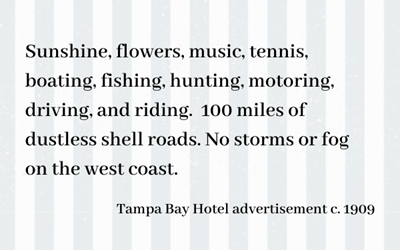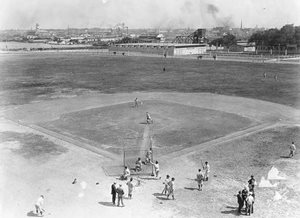The Sportin' Life
During the last half of the 19th century, interest in physical fitness and athletic competitions was on the rise in America. People living in urban and rural regions, across all social classes and from all backgrounds spent a portion of their leisure time engaged in sporting activities. Grand resort hotels offered America’s leisure class an array of socially acceptable entertainments of varying levels of vigor while away from home. The Sportin’ Life dives into the sporting lifestyle of the upper class at America’s grand resorts from the 1880s through the 1930s.

America’s prominent resorts, nestled amid mountains or overlooking picturesque bodies of water, provided many opportunities for the pursuit of pleasure and fitness outdoors. The opulent accommodations and elaborate facilities at destinations such as the Tampa Bay Hotel, The Breakers Hotel, The Grand Hotel, The Greenbrier, Hotel del Coronado or Mount Washington Hotel were designed to attract and entertain the leisure class
 .
.
Mount Washington Hotel, Bretton Woods, New Hampshire, circa 1900. Courtesy of Library of Congress.
Sprawling grounds accommodated bicycling, croquet, horseshoes, hunting and fishing, racing of various types, driving, walking, archery, horseback riding, table tennis, shuffleboard and bowling. Boating and bathing were popular pastimes at waterfront hotels. Elegant spa facilities included natatoriums for indoor swimming. For those who enjoyed competition, neatly manicured landscapes surrounded tournament-worthy golf links and lawn tennis courts. In Florida, Henry Plant and Henry Flagler built baseball diamonds to host exhibition games at the Tampa Bay Hotel, The Royal Poinciana Hotel and The Breakers Hotel. Travel brochures and advertisements touted the variety of sporting activities and the unparalleled quality of the facilities.
 Tampa Bay Hotel advertisement, Life magazine, 1913.
Tampa Bay Hotel advertisement, Life magazine, 1913.
Resorts responded to the public’s growing interest in competitive sports by organizing tournaments or exhibition games of tennis, golf, racing of all types or baseball. Some hotels fielded baseball teams comprised of employees that played against local teams and hosted professional ball teams for spring training.
 Washington Senators spring training at Plant Field, Tampa, 1923. Courtesy of Tampa-Hillsborough County Public Library System.
Washington Senators spring training at Plant Field, Tampa, 1923. Courtesy of Tampa-Hillsborough County Public Library System.
The Tampa Bay Hotel hosted the Chicago Cubs in 1913 and the Washington Senators for spring training in the 1920s. During the 1922-23 season, Kenesaw Mountain Landis and five future baseball hall-of-famers were among the players who stayed at the Tampa Bay Hotel.
Underwritten By
Thanks to
Archive Farms
Wayne Ayers
Belleview Inn archives/Joey Vars
Shelley Copeland
Kathy Durdin
Elliott Museum
Kaylee Farrell
Museum of Florida History, Tallahassee
Florida State Archives
Jo Hopper
Hotel del Coronado
International Tennis Hall of Fame
La France Vintage Clothiers
Library of Congress
John Osterweil
PGA Tour Entertainment
Amy Sakovich
Sarasota County Historical Resources
Earl A. Smith, M.D.
Mike Stevens
St. Petersburg Museum of History
St. Petersburg Shuffleboard Club
Tampa-Hillsborough County Public Library System
Tampa Yacht & Country Club
The Greenbrier
Eldon and Kenton Trubee
Mrs. James Turner, née Joan Holtsinger
World Golf Hall of Fame & Museum